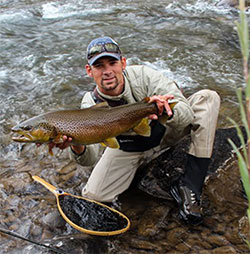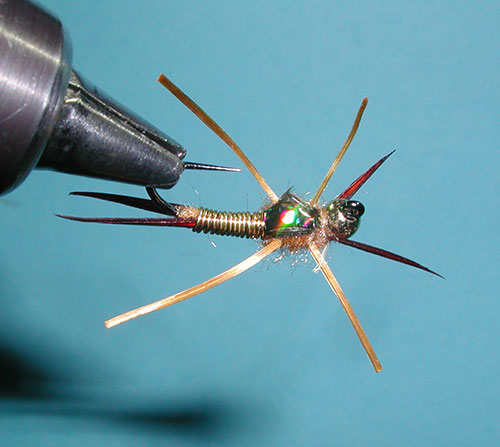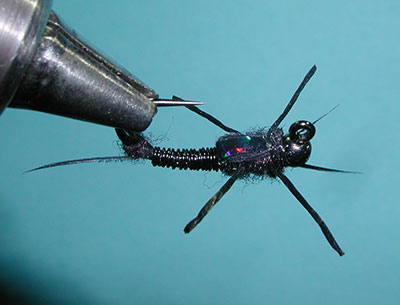|
Notes:
 The Tungsten Jigstone is a pattern from Arlo Townsend of Reno, NV. Arlo guides on the Truckee River and Pyramid Lake. He has about 5 patterns marketed by Umpqua Feather Merchants. The Jigstone rides inverted along the stream substrate and snags less than traditional stonefly nymphs. It is a heavy nymph with a tungsten bead, copper wire abdomen, and leadfree wire under the thorax. Use the larger sizes, #8 and #10, for the short and fast holding lies of the stream and the smaller sizes #10 and #12 for the lesser currents and depths. Many will fish the Gold version in clear water and the Black version in turbid conditions. As with many patterns, the use of materials change with time. Originally, I tied this pattern with an underbody of Antron dubbing underneath the wire wraps of the abdomen. The current version as tied by Arlo omits this step and builds a tapered underbody through the use of thread alone. This provides a more streamline silhouette. Another modification is the wingcase which originally was Swiss Straw but has been substituted for Turkey segments with a Holographic Tinsel strip. This modification gives the pattern much more flash. The Tungsten Jigstone came from Arlo's experiences on the Truckee dealing with fast moving pocket water. According to Arlo: The Tungsten Jigstone is a pattern from Arlo Townsend of Reno, NV. Arlo guides on the Truckee River and Pyramid Lake. He has about 5 patterns marketed by Umpqua Feather Merchants. The Jigstone rides inverted along the stream substrate and snags less than traditional stonefly nymphs. It is a heavy nymph with a tungsten bead, copper wire abdomen, and leadfree wire under the thorax. Use the larger sizes, #8 and #10, for the short and fast holding lies of the stream and the smaller sizes #10 and #12 for the lesser currents and depths. Many will fish the Gold version in clear water and the Black version in turbid conditions. As with many patterns, the use of materials change with time. Originally, I tied this pattern with an underbody of Antron dubbing underneath the wire wraps of the abdomen. The current version as tied by Arlo omits this step and builds a tapered underbody through the use of thread alone. This provides a more streamline silhouette. Another modification is the wingcase which originally was Swiss Straw but has been substituted for Turkey segments with a Holographic Tinsel strip. This modification gives the pattern much more flash. The Tungsten Jigstone came from Arlo's experiences on the Truckee dealing with fast moving pocket water. According to Arlo:
"The Tungsten Jigstone has all of the charateristics of an effective stonefly pattern. It is heavy, easy to tie, a little flashy, durable, and contains the strike inducing rubberlegs, The Tungsten jigstone separates itself from other stone imitations at it's skeleton. It is tied on a TMC 403blj jig hook (#8,10,12) with a tungsten, slotted, faceted bead which saves the angler from losing countless flies amonst the bottom of snaggy pocket water (hook point rides inverted. The jigstone lessens the amount of lost flies and increases valuable fishing time."
"I fish the Jigstone individually with no trailer. Jig hooks don’t always cooperate with other nymphs within the same rigging (tangles occur frequently). Single nymph rigs offer less rigging, easier casting, and less opportunities for tangles. Additional nymphs on the leader are also often the culprit for fish being lost during the battle due to exposed hooks (the hook not in the trout’s mouth) snagging structure during the fight."
“The fly is cast directly above the pocket, the rod tip parallel to the water at the finish. As the fly races downstream and through the pocket, the rod tip is kept pointed at the spot where the fly should be. When the fly clears the lower end of the pocket, it is immediately picked up and shot back upstream. The above is repeated ten or fifteen times in rapid succession . . . This type of water should be stone fly water . . . “
"This is a nymphing technique called the Pot Shooting Method described by Charles E Brooks in his book The Trout and the Stream (1974). Mr. Brooks' description of fishing heavy stone fly nymphs on stout tippets intrigued me from the get go, and was the inspiration of the Tungsten Jigstone. Stone fly imitations work well throughout the Truckee River. The Tungsten Jigstone is heavy, durable and do-able. A philandering little nymph, triggering cues of acceptance, exposing flash and displaying class. Euro nymph it. Dead drift it. Fish it under a bobber. Fish it by itself. Fish it with others. Just fish it. It is the spark which ignites the fire of an absolutely well-thought out technique, gifted to us by a great mind of the past. Bless you Mr. Brooks. Behold the mighty Jigstone!"
- Signature Tyer Arlo Townsend
|



